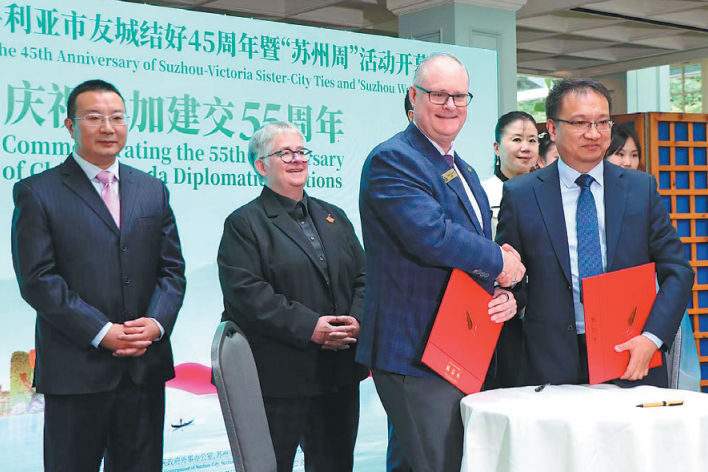Sino-LAC partnerships fuel region's green push


Latin America and the Caribbean countries are at a crossroads in their pursuit of sustainable development. Virtually all LAC countries have pledged to cut greenhouse gas emissions and achieve net-zero carbon by midcentury. Yet turning climate pledges into reality requires investment and technological support — areas where these nations face shortfalls. Decades of dependence on commodity exports and fossil fuels have left many LAC economies struggling to finance a green transformation. Upgrading energy infrastructure, building renewable power capacity, electrifying transport and conserving critical ecosystems demand capital and technology on an unprecedented scale.
The 33 LAC countries form an integral part of the Global South — a grouping in which China also positions itself. Regional leaders are pursuing green reindustrialization, renewable energy expansion and climate resilience as pathways to address economic inequality and environmental vulnerability. This is where China's role becomes pivotal, stepping in with the funding and know-how to bridge the gap between vision and implementation.
Over the last few years, a clear shift has occurred in Chinese investment. Chinese capital in 2022 and 2023 rebounded and pivoted toward renewable energy projects and clean-technology industries.
Many of these new investments are led not by giant State-owned enterprises alone, but by China's private sector champions in clean tech that are expanding the green footprint in Latin America beyond traditional big infrastructure deals.
Concrete examples of this green push abound. In Argentina's sunny Jujuy Province, for example, financing from China Development Bank helped build a solar power plant with a sprawling 300-megawatt array that now lights up hundreds of thousands of homes. These projects are more than sporadic investments; they represent a growing mosaic of Chinese-backed renewable-energy infrastructure.
Beyond power generation, China is also wiring Latin America for the green transition. State Grid Corp of China has invested heavily in Brazilian power transmission lines to connect remote hydro dams and wind farms with urban centers.
This helps resolve a critical bottleneck: Many Latin nations have ample renewable resources but lack the transmission infrastructure to deliver that energy where it's needed, and Chinese companies are stepping in to build that connective tissue.
Complementary strengths
The accelerating green partnership between China and Latin America is underpinned by complementary needs. Latin America requires large-scale funding, infrastructure upgrades and affordable technology to fuel its green transition. China has exactly those resources in abundance — along with a strategic interest in exporting its green development model.
Consider renewable energy technology. Over the years, China has become a leader in solar panels, wind turbines and battery storage.
Chinese manufacturers have pushed down the cost of solar modules by more than 80 percent in the past decade, making solar power far more accessible. Latin America, blessed with intense sunlight and strong winds, stands to gain enormously from these cheaper technologies. By importing Chinese solar panels or partnering with Chinese companies to build wind farms, countries such as Chile, Mexico and Brazil are expanding their clean energy capacity.
Chinese expertise — from ultrahigh-voltage grid design to electric bus manufacturing — is helping Latin America leapfrog toward modern, low-carbon systems. This tech transfer is often bundled with financing from China's development banks or commercial lenders, creating a one-stop solution for Latin American governments looking to implement green projects quickly.
There is also a strong social and human dimension to these projects. Latin American leaders are keen that the green transition also be a just transition — one that creates jobs, reduces inequality and respects local communities. Here, too, China's role can be positive. Many Chinese renewable projects have brought employment and training to local residents, as seen, for example, with the Bahia wind farm's 1,000 jobs in Brazil. And by contributing to cleaner air and water, these collaborations directly improve quality of life.
To maximize mutual gains, Latin American governments are encouraging Chinese investors to form joint ventures, use local suppliers and transfer skills. When managed well, China's green investments can thus become a catalyst for Latin America's broader sustainable development, aligned with the region's goals of inclusive growth.
Greener partnership
Despite the promising alignment, China's burgeoning role in Latin America's green transition is not without challenges. One major hurdle is navigating the regulatory and political complexities across nations. Each country has its own legal framework, approval process, and standards for environmental and social safeguards. Projects could be delayed or derailed by permission issues, community protests or shifts in government.
There is also a challenge of aligning priorities. While both sides want sustainable development, Latin American governments often emphasize that it must directly benefit local populations. As noted, reducing inequality is a key concern; green projects are expected to create jobs and social value, not just generate electrons or extract minerals. Building trust through local partnerships, hiring and training local workers and engaging transparently with communities are essential.
The awareness of this need is growing. Some Chinese investors are currently pursuing joint ventures with Latin companies or sourcing components locally to meet the host country's expectations.
Sustainable future
As the world races to curb carbon emissions and avert climate catastrophe, the green transformation of LAC has become a matter of global significance. In this endeavor, China's role has emerged as both impactful and indispensable.
Through sizable investments, technology transfer and a shared vision of progress, China is helping to unlock Latin America's tremendous sustainable development potential. From the windswept plateaus of Argentina to the tropical sun of the Caribbean, solar panels, wind turbines and electric vehicles financed by Chinese partnerships are accelerating the region's shift to a low-carbon economy. This is happening in a way that aligns with Latin American aspirations — creating jobs, upgrading industries and fostering inclusive growth.
Looking ahead, the promise of the China-LAC green alliance is bright. Both sides are doubling down on climate action: China has committed to peak its carbon emissions before 2030 and achieve carbon neutrality before 2060, while Latin American nations are pushing forward with renewable-energy expansions and nature-based climate solutions. Their partnership can be a powerful engine driving these commitments from paper to practice.
The author is director of research at the Institute of Innovative and High-Quality Development (Hong Kong).
































